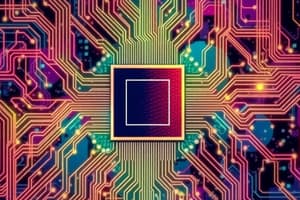Podcast
Questions and Answers
What is the purpose of the core in the CPU?
What is the purpose of the core in the CPU?
The purpose of the core in the CPU is to carry out the fetch-decode-execute cycle, and to execute instructions.
How does increasing the number of cores in the CPU affect performance?
How does increasing the number of cores in the CPU affect performance?
Increasing the number of cores in the CPU increases performance because more instructions can be processed simultaneously.
What is the role of a register?
What is the role of a register?
To store data temporarily.
What does the address bus do?
What does the address bus do?
What does the data bus do?
What does the data bus do?
What does the control bus do?
What does the control bus do?
What does a router do?
What does a router do?
What does an IP address do?
What does an IP address do?
What does a network interface card do?
What does a network interface card do?
What does a manufacture ID do?
What does a manufacture ID do?
What type of translator executes and converts the code line by line?
What type of translator executes and converts the code line by line?
What type of translator creates an error report displaying all the errors in the code?
What type of translator creates an error report displaying all the errors in the code?
What type of translator creates an executable file?
What type of translator creates an executable file?
How can we avoid the cybersecurity threat of phishing?
How can we avoid the cybersecurity threat of phishing?
What is meant by social engineering?
What is meant by social engineering?
What are access levels?
What are access levels?
What are the similarities between IPv4 and IPv6?
What are the similarities between IPv4 and IPv6?
What are the differences between IPv4 and IPv6?
What are the differences between IPv4 and IPv6?
What system stores a database of uniform resource locators and their corresponding IP addresses?
What system stores a database of uniform resource locators and their corresponding IP addresses?
What software sends a request to the IP address to obtain the web page data?
What software sends a request to the IP address to obtain the web page data?
How is virtual memory used?
How is virtual memory used?
What manages files, memory, and multitasking?
What manages files, memory, and multitasking?
What is meant by managing memory?
What is meant by managing memory?
Flashcards
Purpose of CPU Core
Purpose of CPU Core
To carry out the fetch-decode-execute cycle and execute instructions.
Impact of Increasing Cores
Impact of Increasing Cores
Increasing the number of cores increases performance by processing more instructions simultaneously.
Role of a Register
Role of a Register
To store data temporarily within the CPU.
Function of Address Bus
Function of Address Bus
Signup and view all the flashcards
Function of Data Bus
Function of Data Bus
Signup and view all the flashcards
Function of Control Bus
Function of Control Bus
Signup and view all the flashcards
Function of a Router
Function of a Router
Signup and view all the flashcards
Purpose of IP Address
Purpose of IP Address
Signup and view all the flashcards
Network Interface Card
Network Interface Card
Signup and view all the flashcards
Manufacturer ID
Manufacturer ID
Signup and view all the flashcards
Interpreter
Interpreter
Signup and view all the flashcards
Compiler
Compiler
Signup and view all the flashcards
Pharming Prevention
Pharming Prevention
Signup and view all the flashcards
Social Engineering
Social Engineering
Signup and view all the flashcards
Access Levels
Access Levels
Signup and view all the flashcards
IPv4 and IPv6 Similarities
IPv4 and IPv6 Similarities
Signup and view all the flashcards
Differences Between IPv4 and IPv6
Differences Between IPv4 and IPv6
Signup and view all the flashcards
DNS Functionality
DNS Functionality
Signup and view all the flashcards
Web Browser Function
Web Browser Function
Signup and view all the flashcards
Virtual Memory Use
Virtual Memory Use
Signup and view all the flashcards
Operating System
Operating System
Signup and view all the flashcards
Memory Management
Memory Management
Signup and view all the flashcards
Study Notes
CPU Core Function
- The CPU core carries out the fetch-decode-execute cycle and executes instructions.
CPU Core and Performance
- Increasing the number of cores in a CPU improves performance by allowing more instructions to be processed simultaneously.
CPU Registers
- Registers temporarily store data.
CPU Buses
- The address bus transmits addresses between CPU components.
- The data bus transmits data between CPU components.
- The control bus transmits control signals from the control unit to other CPU components.
Routers
- Routers forward packets to their correct destinations on a network.
IP Addresses
- IP addresses uniquely identify devices on a network, assigned by the network.
Network Interface Cards (NICs)
- NICs enable devices to connect to a network.
Manufacturer IDs
- Manufacturers IDs are used to uniquely identify devices.
Translators (Interpreters vs. Compilers)
- Interpreters execute and convert code line-by-line, stopping if errors are detected.
- Compilers create an error report displaying all errors and create an executable file.
Avoiding Pharming Threats
- Be cautious of email/website spelling, tone, and URLs.
- Scan downloads with anti-malware software.
- Download from trusted sources.
- Avoid providing personal details online.
Social Engineering
- Social engineering manipulates people to obtain data (e.g., insurance fraud).
Access Levels
- Access levels control user permissions for data.
- Users can view/read, edit/delete, or change data based on assigned levels.
- Access levels are often connected to usernames.
IPv4 and IPv6 Similarities
- Both are used to identify devices on a network.
- Both can be static or dynamic, public or private.
IPv4 and IPv6 Differences
- IPv4 is decimal (separated by dots), IPv6 is hexadecimal (separated by colons).
- IPv4 has four groups of digits, IPv6 has eight.
- IPv4 values are between 0 and 255; IPv6 values are between 0000 and FFFF.
DNS
- The Domain Name System (DNS) stores a database of Uniform Resource Locators (URLs) and their corresponding IP addresses.
Web Browsers
- Web browsers send requests to IP addresses to obtain webpage data.
Virtual Memory
- Virtual memory uses secondary storage space partitioned to create virtual memory.
- Files can move between primary (RAM) and virtual memory.
- This management allows for more simultaneous tasks (multitasking).
Operating Systems
- Operating systems manage files, memory, and multitasking.
Memory Management
- Memory management involves tracking memory locations, data movement in/out of RAM, ensuring adequate memory for processes, preventing process interference by preventing accessing the same memory location and transferring pages between virtual/RAM memory.
- It enables multitasking.
Studying That Suits You
Use AI to generate personalized quizzes and flashcards to suit your learning preferences.




